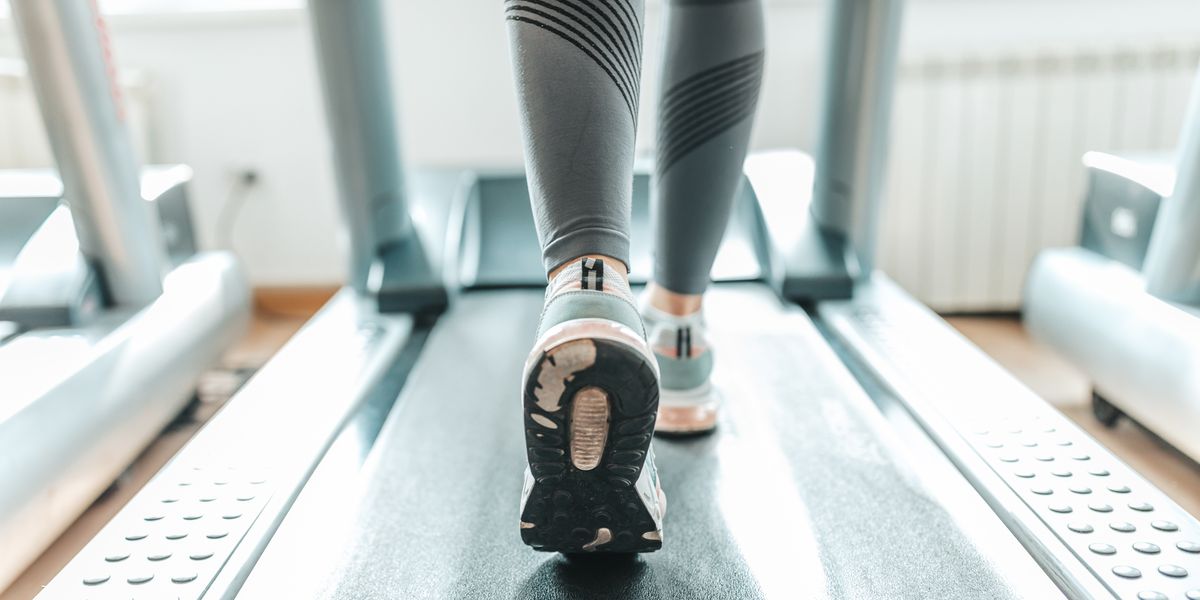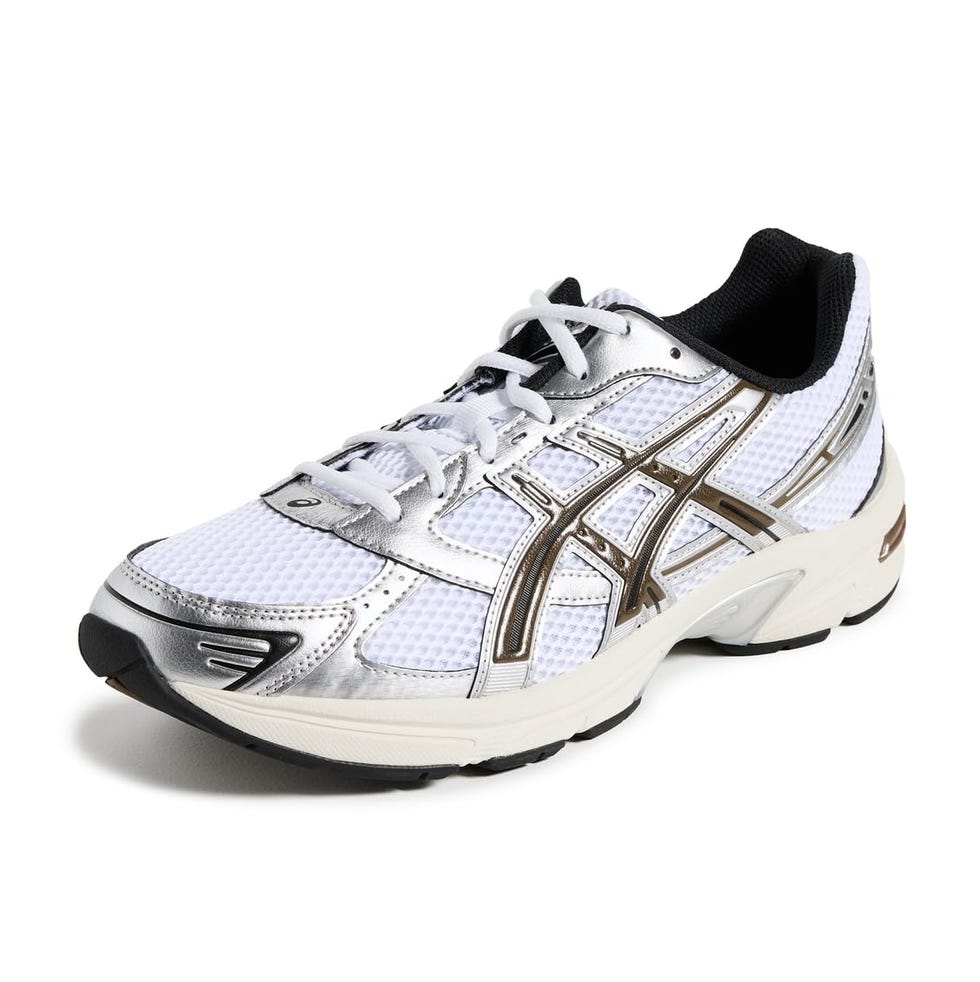There’s a reason everyone you know is doing the 12-3-30 workout. Invented in 2019 by content creator Lauren Giraldo, who went viral for claiming that simply walking uphill on a treadmill helped her lose 30 pounds, the workout has become a mainstay for walking fanatics ever since.
In her TikTok video, which now has over 14 million views, Giraldo lays out her formula: Walk on a level 12 incline at a 3-mile per hour speed for 30 minutes. Yep. It’s *that* simple, but it gets intense fast. On TikTok, people say the trend has helped them lose weight, burn fat, and more—and they rave about the changes they’ve seen in their bodies after doing the workout consistently.
And, while there are a bunch of benefits to incline walking, you might still be wondering if this buzzy routine is worth the hype. Ahead, fitness experts weigh in on the trend and whether or not it’s worth adding to your gym routine.
Meet the experts: April Gatlin, CPT, is a certified personal trainer and coach for STRIDE Fitness. Haley Gott, CPT, is a certified personal trainer and dance coach. Gail McGhie, CPT, is a certified personal trainer and founder of Gail McGhie Fitness. Grayson Wickham, PT, DPT, CSCS, is a physical therapist and the founder of the stretching app Movement Vault. Claudette Sariya, CPT, is a NASM-certified personal trainer, health coach, and the founding instructor at Sole+ Studios.
What is the 12-3-30 workout?
First, set your treadmill to an incline of 12 and a speed of three miles per hour. Then, walk for 30 minutes. That’s it!
If you can do five 12-3-30 workouts a week, which is what Giraldo suggests, you’ll hit the recommended 150 minutes of moderate-intensity exercise recommended by the CDC.
But, if you’re a new exerciser and five days a week feels a little over the top, doing the 12-3-30 method for two or three days a week combined with other types of training is plenty, says Haley Gott, CPT, a personal trainer and dance coach.
When you’re not doing 12-3-30, you can work in some other types of exercise to keep up your fitness. Interval training, weight training, or even swimming workouts are great options to help you get active, says Gail McGhie, CPT, a personal trainer and founder of Gail McGhie Fitness. One pro tip for 12-3-30 fanatics? Look for exercises in the lateral plane (side-to-side motion), she says, since the treadmill only pushes your body to do one type of forward motion.
Overall, 12-3-30 can be a well-rounded, effective workout since it activates many parts of your body. When you walk on a treadmill with an incline, posterior muscles like your glutes, hamstrings, calves, and back are activated, says April Gatlin, CPT, a personal trainer and coach for STRIDE Fitness, a total body HIIT and treadmill workout. It’s a form of resistance training, and you’re building strength in your glutes, hamstrings, back, and core muscles, she adds.
On top of that, the speed adds more difficulty. Three mph might not sound that fast, but combined with the incline, you’ll definitely feel the burn. Your heart rate will also rise since you’re working harder to move at a quicker pace, Gatlin says. And although the workout may feel super tough at first, if you’re consistent over time, your body will adjust to that quicker speed as your body adapts to its “new normal” working capacity.
Potential Benefits Of The 12-3-30 Workout
It could help you get stronger.
For starters, the 12-3-30 treadmill routine is a banger of a lower-body workout, says Gott.
“It’s a great way to activate multiple muscle groups in your legs.” Your quads, hamstrings, glutes, and calves are all firing, which means that over time, it can help you build lower-body strength.
It helps your heart.
If your current cardio routine needs a shake-up, the 12-3-30 workout could be a helpful addition to build endurance and boost cardiovascular health, says Gott. Moderate-intensity walking, three to five times per week for three months significantly lowered systolic blood pressure, according to a 2021 study in Cochrane Database of Systematic Reviews.
You’ll burn lots of calories.
Those claims that the method burns hundreds of calories are true, Gott says. One 12-3-30 workout sesh can burn anywhere between 300 and 800 cals, to be specific. (The exact number will vary depending on your current weight since it takes more energy expenditure to move more mass, says Claudette Sariya, CPT, a personal trainer.) In comparison, most people tend to burn at least 100 calories per mile when running—but again, this number will vary depending on the person and their fitness.
For some, this means running might be a more efficient way to achieve the same caloric burn (if you’re running faster than a ten-minute mile, for example), Sariya says. That said, increasing the incline of a walk is one sure-fire way to ramp up the burn of this lower-impact activity.
It could help reduce your risk of injury.
If you need a break from high-intensity training but still want a workout that packs a major punch, 12-3-30 is a great alternative. The 12-3-30 workout itself is tough, but unlike running, this routine puts less stress on the bones, ligaments, and tendons, says Gatlin.
“With 12-3-30, or any higher intensity incline walking, there is one foot soundly planted on the ground at one time, making the body more stable and the risk of injury lower,” she says.
The workout is beneficial for your bones, too.
Incline walking is a weight-bearing exercise, so with the resistance the body creates, you naturally strengthen your bone density, says Gatlin. Exercise also slows bone loss, according to the Mayo Clinic, so this trendy treadmill routine could be a winner for your health.
It may help with weight loss—if you’re consistent.
It’s important to note that weight loss is determined by many factors from caloric intake to your genetics to moving your body regularly, Gott says, and any potential weight loss from doing the 12-3-30 workout will vary from person to person.
If you’re trying the workout specifically to lose weight, the key is to stick with it. “Find ways that you can add in your walks that will help you stay consistent, because the more often you walk, the more weight loss you will have,” Grayson Wickham, PT, DPT, CSCS, founder of Movement Vault, previously told Women’s Health.
Potential Risks Of The 12-3-30 Workout
Walking on a steep incline can aggravate your lower back since the intense, repetitive movements can lead to your muscles being overworked, Gott says. To that end, stretching and paying attention to your posture is really important, she says. Relax your shoulders and avoid leaning backwards on the treadmill, which can cause your low back to tense up even more. If you’re feeling any pain or discomfort while doing this treadmill exercise, it’s probably a sign to stop before you put unnecessary strain on your body.
FYI: This isn’t a low-impact workout, and it can stress the body more than you think, says McGhie. This also means that 12-3-30 could lead to injuries for anyone with hip, knee, or ankle issues. “If you have those issues, or you experience low back pain, you should start this workout at a lower incline,” McGhie says. You can still challenge your cardio and your legs at a lower incline, she says, like level three or five.
If you have a history of shin pain or shin splints, this training plan may not be for you, says Gatlin. “To combat shin splints, ensure the body is properly warmed prior to starting the workout and wear the proper type of footwear specific to your gait and stride,” she says.
It’s also important to pay attention to your body as you walk. “When we start to get tired, our bodies will naturally start to compensate,” Gott says. Your body might start relying on other muscles to help you power through (like your lower back muscles, Gott says). She says this can cause discomfort or a change in your stride.
“You don’t even notice it, but when you’re tired, your body just does its own thing,” she adds. So, if you’re feeling any aches and pains beyond your usual post-workout tiredness, consider lowering the treadmill’s incline, taking a break, or stretching your muscles out.
How To Try 12-3-30 Safely
This workout is intense, but modifications can help keep it safe and effective at all levels. If you’re new to this training method (or fitness in general), aim for two to three 12-3-30 workouts a week, Gatlin suggests. Start at 3 mph and a lower incline, like three or five percent. Then, gradually add one percent incline each week as your body adjusts to the added resistance. Once you build strength and cardio endurance, you can up your game and try four or five times per week, if you want.
If you have a solid fitness foundation (previous cardio and strength training experience), you can dive into the official 12-3-30 workout as is and do it five times a week as suggested, says Gatlin.
You can also split up your workout into multiple segments to make it safer and more manageable, Giraldo says. And don’t worry about doing it perfectly. If your treadmill only goes up to a 10, you can still do the workout at 10 instead of 12, she says.
At all levels, proper treadmill form is also key for staying safe and maximizing the benefits, Gatlin says. Here are her tips for practicing safe and correct treadmill form:
- Relax shoulders and hands.
- Keep shoulders rolled back.
- Hold head steady with chin parallel to the treadmill.
- Avoid leaning backwards to maintain upright posture.
- Don’t hold the rails.
If at any point you feel like you’re falling behind on the treadmill unless you grab the rails, that’s a sign to lower the incline. Holding the rails reduces the effect of the incline and breaks proper form which can lead to injury, says Gatlin. While it’s okay to slowly build up to the level 12 incline if you struggle at first, your safety should always be top of mind.
As for how you should feel during and after the workout? In general, “You should feel like you are working hard during the 30 minutes,” says Gatlin. Your heart will be pumping, the glutes and hamstrings will be activated, and you’ll be breathing heavier, she says. This may sound exhausting, but it’s a good thing. Your heart will thank you for it.
You may also notice some soreness in the following 24 to 48 hours after your workout, which is normal, says Gatlin. It’s a sign your body is adapting, and after a few weeks of consistency, you’ll notice major strength gains and improve cardio endurance, she adds. Just throw on your “hot girl walk” playlist of choice, and enjoy your 30 minute sweat sesh.
Lexi Inks (she/her) is a lifestyle journalist based in Jacksonville, Florida. She has reported on countless topics, including sexual wellness, astrology, relationship issues, non-monogamy, mental health, pop culture, and more. In addition to Women’s Health, her work has been published on Bustle, Cosmopolitan, Well + Good, Byrdie, Popsugar, and others. As a queer and plus-size woman with living with mental illness, Lexi strives for intersectionality and representation in all of her writing. She holds a BFA in Musical Theatre from Jacksonville University, which she has chosen to make everyone’s problem.
Olivia Luppino is an editorial assistant at Women’s Health. She spends most of her time interviewing expert sources about the latest fitness trends, nutrition tips, and practical advice for living a healthier life. Olivia previously wrote for New York Magazine’s The Cut, PS (formerly POPSUGAR), and Salon, where she also did on-camera interviews with celebrity guests. She’s currently training for her first half marathon, inspired by her many colleagues at WH who have run one.
Read the full article here







